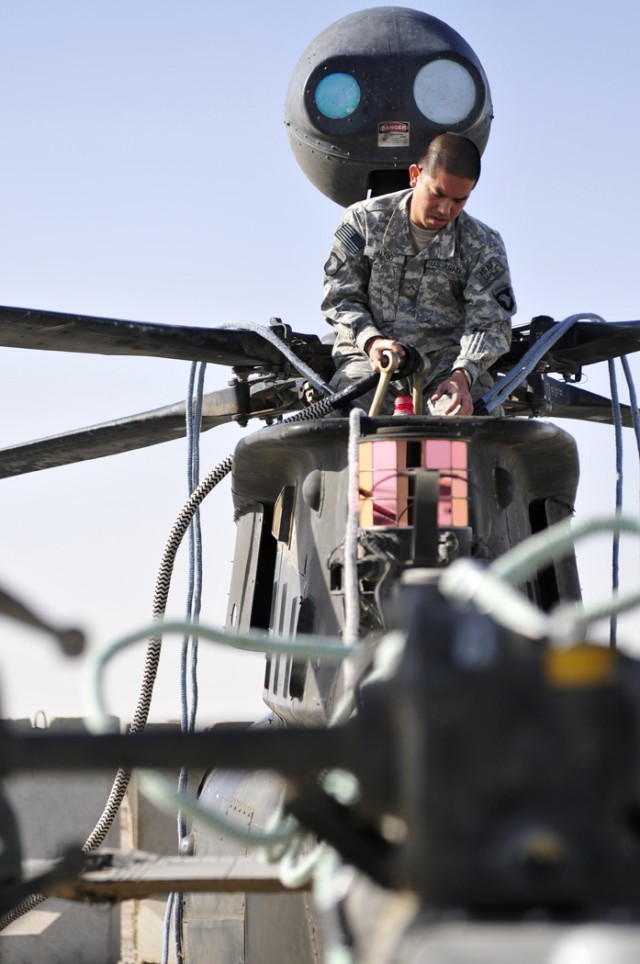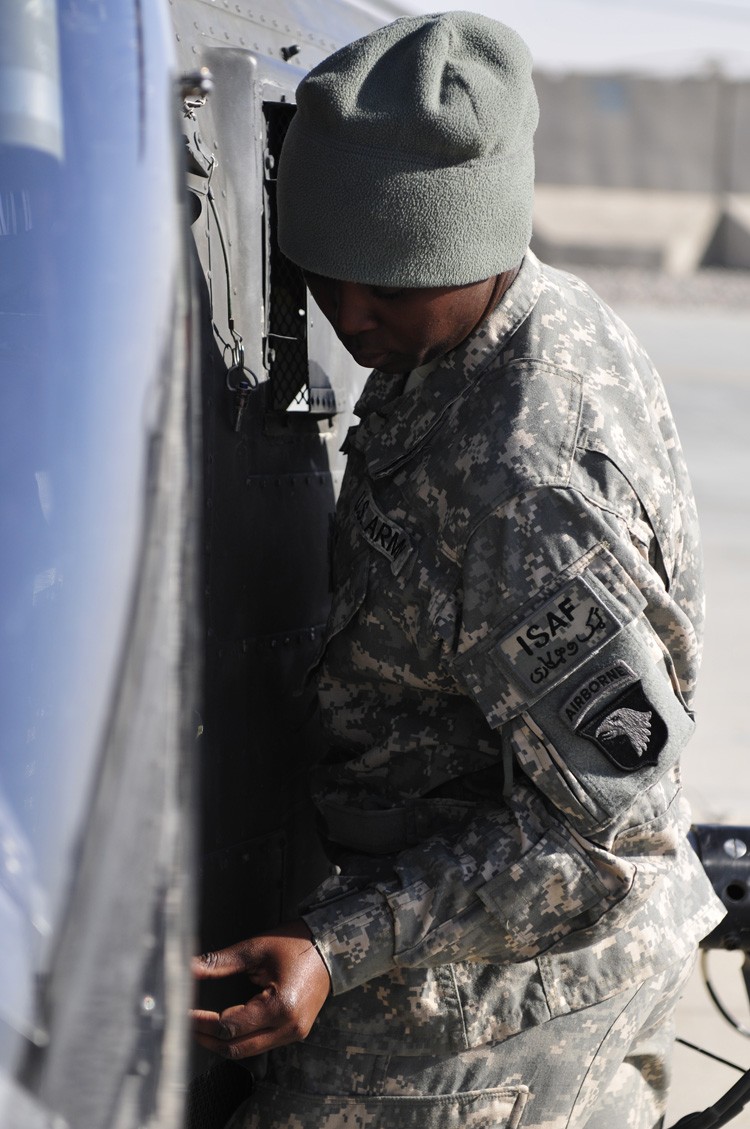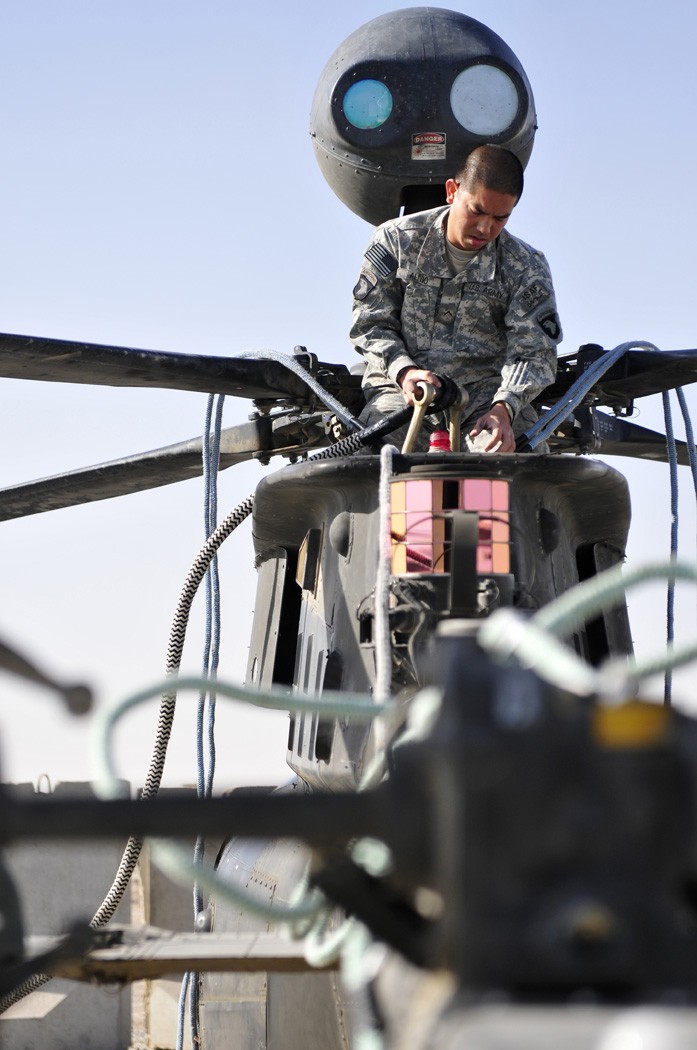The downed aircraft recovery team of D Troop, Task Force Saber is responsible for reacting within minutes to damaged helicopters that are unable to return to Kandahar Airfield.
They must respond immediately to calls from OH-58D Kiowa Warrior and AH-64 Apache helicopter pilots whose aircraft are unsafe to fly back due to an accident, malfunction or battle damage.
A DART consists of a maintenance noncommissioned officer, a specified aircraft maintainer, a technical inspector and the TF Saber Pathfinders who escort and provide additional security.
"The maintainer sent on the DART will depend on the area and the condition of the aircraft," said Sgt. Antonio Williams, D Troop, TF Saber maintenance shift leader. "We try to give every Soldier the opportunity for experience, but the more experienced Soldiers are sent on missions that are higher risk."
There are aircraft maintainers on the team who have the military occupational specialty of airframe, hydraulic, power train, armament and electronics repairers. They are selected for specific missions because of their job skills.
No matter what crew is selected, they are ready to go at any moment.
The troop has conducted battle drills, built DART kits, and assigned different personnel to tasks so they are mission ready within 5 minutes and off the ground in less than 20 minutes from the time a call is received, said Staff Sgt. Jason North, D Troop, TF Saber AH-64 Apache maintenance platoon sergeant.
"We have kits premade for any job we may encounter," said Spc. Brandon Johnson, D Troop, TF Saber OH-58D Kiowa Warrior repairer. "The OH-58 kits are categorized by engine, transmission, tail rotor, hydraulics and generic repairs."
The AH-64 Apache kits are set up similarly.
The Apache team has three boxes prepared for immediate response, the hydraulic, engine and general maintenance kits, said Spc. Jesse Hammond, D Troop, TF Saber AH-64 Apache helicopter crew chief. They may also have to transport an airframe field locker, an extra-large toolbox, depending on the mission.
The kits are stocked with specific parts and tools for a particular job. The DART also takes a multipurpose toolbox for general repairs.
"We researched previous DART missions to put the kits together," said Williams. "We also consider every possible problem and solution."
There are different procedures for some situations, which may require one or two extra steps.
For instance, if a rotor blade needs to be replaced, they would have to take another rotor blade of equal weight so the rotor spin is balanced, said Johnson. If the weights are uneven, the aircraft is difficult to fly.
The aircraft has a track and balancing sensor to alert the maintainers where too much vibration is occurring. Weights may be added to either blade to help even them out and correct the vibrations.
If the helicopter cannot be repaired on the spot, needs special equipment or extensive maintenance to restore it to a safe flying condition, the DART prepares the aircraft for a sling load extraction, said Williams. The troop is trained on sling load operations, but has not had to carry out any this year.
Before the DART can leave, the technical inspector assesses the situation by talking through the problem with the pilot. They gather information to determine what the DART needs in order to repair the aircraft.
"A lot of Kiowa pilots are prior crew chiefs," said Johnson. "But they are all knowledgeable of the aircraft they fly."
Because the kits are geared to grab-and-go, they are ready immediately after the TI communicates the problem to the crew.
Once a DART request is evaluated, the team rushs to gather the necessary tools, kits and equipment needed for a successful mission, said North. Since everyone has their own role in preparing for the mission, the team is able to pull everything together in minutes.
The TI travels with the two maintainers to the sight of the aircraft.
They are responsible for determining the maintenance necessary to get the pilots and aircraft in the air and back to KAF safely, said Sgt. Glenn Wendland, D Troop, TF Saber technical inspector. They work with the pilots to resolve the problem and establish a safe flying condition as quick as possible.
"We want to be in-and-out of there as fast as we can, while taking the proper precautions for the safety of the pilots," said Wendland. "Once the maintenance is complete, I conduct a final inspection to verify air worthiness."
Depending on the state of the aircraft, pilots try to land at the closest camp or forward operating base.
"Pilots train to know their limits on how far they can fly depending on what the situation is," said Williams.
Once the personnel and aircraft are safely returned to KAF, they apply after action maintenance.
"Our job is to restore the safety of the aircraft for the pilots to fly back," said Hammond.
Since the DART only repairs what is necessary to recover the aircraft and crew, it is essential to conduct further maintenance checks and procedures to return the aircraft to its optimal flying condition.
DART has successfully recovered six Kiowa Warriors and five Apaches during this deployment.
The pilots and aircraft returned safely due to the speedy and precise actions of these crews, and the teamwork and readiness of the troop.




Social Sharing